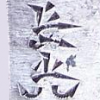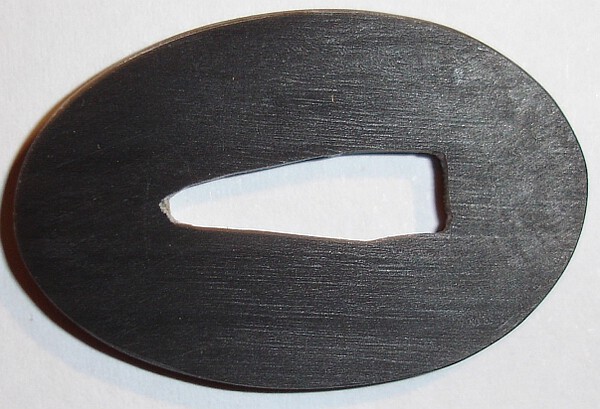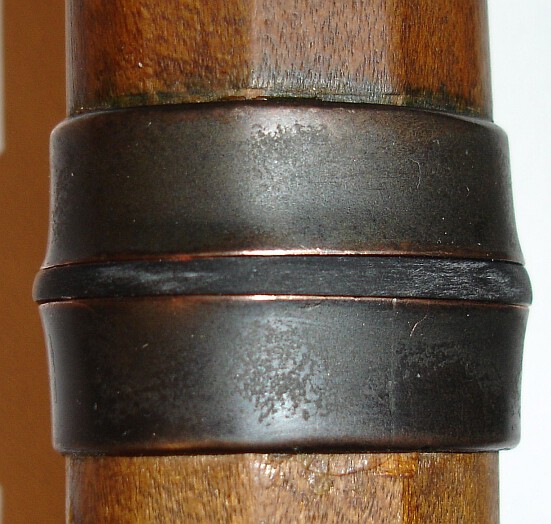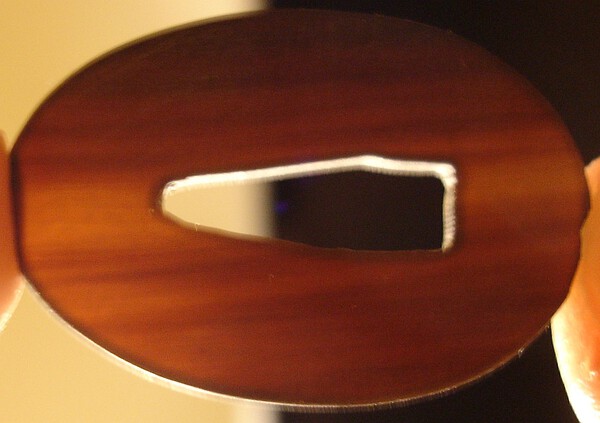-
Posts
464 -
Joined
-
Last visited
Content Type
Profiles
Forums
Events
Store
Downloads
Gallery
Everything posted by Drago
-
第三帝国 could be Third Reich but also "third imperial" 海中部 underwater or sea division 百有餘回?坊 100, more than, return, ?? -> 回忌 (anniversary?) but neither the Third Reich's/Germany's nor the Empire of Japan's military had existed for 100 years in 1935... Sorry, can't figure out more. I hope Morita-dono can help. Please post full pictures of the blade and koshirae.
-
Hi, I seem to recall (either here or elsewhere) a text/website that showed the process of how kao (Japanese "signatures") are constructed - the way from the individual kanji to the signature. Could somebody point me to this if you know? Thanks!
-
Malcolm, very interesting! Thank you very much.
-
Thank you very much!
-
Thank you Steve and Morita-dono, but what are those to kanji after the Keisen? EDIT: Oh, Morita-dono, I think you are right. http://item.rakuten.co.jp/auc-agmaeda/nihonga-keisen/ has a similar signature and the kanji after Keisen are better readable.
-
Hi guys, I bought a new set of shikishi and this is the centerpiece. I just fell in love with it when I first saw it. Only downside is it is landscape format, not protrait, so it doesn't fit on my shikishi scroll - so what do I do now? Unfortunately I can't figure out what it says on the sleeve. What I have so far is not much: 金魚xx and the name xxxx I'd appreciate any help. Oh, and if anyone knows what kind of painting technique that is, I'd like to know. It's definitely not oil or ink. But it is raised, so it must be some kind of paste or plaster...
-
Thank you very much Guido. That was very informative!
-
The signature is 河内守藤原國助 - the last kanji is 助 (ジョ and すけ / たす - the same kanji used for "to help/rescue" btw.) not 肋 - but they do look pretty similar, don't they? I use this website http://nihontoclub.com/view/smiths/meisearch to search for names/rest when I figure out parts of the signature or know the name in English.
-
Hi Gwyn, 1. Yes. 2. http://www.jssus.org/nkp/common_kanji.html This explains the titles a bit. But it doesn't mean he was the "boss" of Kawachi Province! 2.5 I always wondered, how did a swordsmith get these titles anyway? Who gives those to him? Did the Daimyo ruling over Kawachi give Kunisuke that title as a thanks for superior work? Because if not, wouldn't that Daimyo have a problem with that? Were any lands given with the title like a hatamoto title or was it just a title to add to your name? And how did he get that Fujiwara-clan title. The clan didn't really exist anymore as such a powerful entity... 3. Sorry, others will have to help with that one.
-

Nihon No Bi: Nihonto (The Japanese Sword)
Drago replied to Paul Martin's topic in General Nihonto Related Discussion
Why did I only see this now? Anyway, before I "cast my vote", a question for Paul: Does the Doujigiri Yasutsuna happen to be in the book with pictures? -
Hi, It is definitely Chinese. As to the "why": 1. "hada" (the grain of the blade) is too visible and coarse - nothing like on a real sword 2. ito binding (handle wrapping) is completely wrong 3. quality of the tsuba and other fittings is terrible (even when compared to low-quality (real) NCO swords) 4. strange step where blade meets habaki (blade collar)
-
Thanks for the answer. You're right. But still, in general: What motifs fit which seasons?
-
Hi guys, I'm trying to "soup up" my Japanese corner and since I have always been interested in hanging scrolls, I'd like to get a few. Now, I know that in Japan they are typically changed to fit the season or certain events. Unfortunately, I haven't really found "a list". So the question for you folks is: What motifs symbolize which season? (e.g. plum blossoms = early spring) And furthermore: When do you hang sansui scrolls with no clearly identifiable season depicted on them (black-and-white landscapes)? Thanks a lot in advance!
-
Hi, are there any special reasons why there are different nakago shapes like futsu, funagata, kijimomo or furisode? Is this merely an individual/school thing, or the fad of certain eras or is there any functional rationale behind those shapes? Thanks!
-
Very interesting. Thanks for sharing! You don't see many muratato for sale - is that because they are considered non-traditional like showa swords and are illegal in Japan?
-

Experience With David Csaba Of Hungary (Sword Bags)?
Drago replied to Drago's topic in Auctions and Online Sales or Sellers
No one? -
Hi guys! I've been looking for a katanabukuro for a -long- time now and haven't really found anything (even if only the materials with the right design) But today I found this website of David Csaba https://sites.google.com/site/katanabukuro/home. I like the designs he makes and was thinking of having him make a bag or two for me. Now I wonder, does anyone of you have any experience with him? Thanks!
-
Hi guys, I promised to show you the VERY intriguing sword I bought recently. Well, here it is: It is a miniature katana signed 濃州住志津三郎兼氏之鍛 (Noshū Jū Shizu Saburō Kaneuji kore kitau) signed in toshin-mei. I would not call this a chigozashi (boy's sword) because of the measurements: nagasa 22.85 cm mihaba 1.775cm motohaba 1.375cm It just seems too small for a boy's sword and too thin for a tanto. The blade geometry really makes it look like a miniature sword. (btw. It was sold as a puppet sword.) The blade has seen some polishes and the current polish looks pretty good. The hamon seems mostly yahazu with tobi-yaki and some gunome midare. No hada visible but I think I see some nie. The habaki seems to be made from solid silver (judging from the weight, no copper shining through, no green oxidation and no visible plating near scratches). The questions I haven't been able to answer yet: 1. Who is the smith? There were 2 Kaneuji that signed similarly (KAN2864 and KAN2866). 2. What kind of sword is this really? 3. Would a solid silver habaki really be possible here? 4. What is the symbol on the nakago? It's the wrong way around for a katakana NA... I'd like to hear your opinions about this sword! And don't mind sharing if you have any ideas on how to answer my questions. (n.b.: Sorry about the quality of the photos. I'm not much of a photographer. Also, the photos aren't to scale, I just put some together as they came.)
-
Good evening guys, Here, as promised, the photos of my solution. I bought some horn and drilled, filed and sanded it into shape. One photo shows the "seppa", the other one mounted on the sword and the third a photo against the light - beautiful pattern. I never worked with horn before and I was quite surprised about how nice it is to work with. It can be worked precisely and without splintering if you're not stupid about it. Only thing I didn't like was the smell of powdered horn. The same disgusting smell of having your teeth drilled. photo.jpg The current finish you see on the "seppa" is the result of 500 grain wet sandpaper. I don't have anything finer at the moment. And I'm not sure if I'll polish it anyway, the fittings aren't shiny either... mounted.jpg You might notice on the pic that it seems one side of the "seppa" is thicker than the other. That is really the case. The habaki and tsuka don't line up but I didn't want to modify those, so I made the piece slightely slanted. light.jpg I just couldn't get the camera to focus without shaking it while pressing the trigger. Sorry about that. And one final comment: Goddamn I'm glad that worked out on the first try!
-
Haha, sorry. Work has been keeping me busy. I'll post picts of my solution later today, and the blade on Wednesday or Thursday.
-
I'll post pics in the Nihonto section when I get good ones. So far, all have been completely unrecognizable.
-
Hi guys, I bought a VERY interesting sword recently which I will share for discussion as soon as I manage to take some decent pictures. The sword is mounted in a quasi-shirasaya (shakudo bands at fuchi and sayaguchi, kojiri and kashira are shakudo caps) It seems to be the original shirasaya but the blade has seen some polishes so a new habaki might have been made. Now here's the question: Between the habaki and the tsuka there is a gap of about 2mm. What can I do here? 1. Mount a tsuba without seppa 2. Mount multiple seppa 3. add a piece of horn 4. add a piece of shirasaya wood 5. ??? I'm looking forward to your answers.
-
The last two kanji are "入道" (nyuudou), refering to someone who entered a monastery, shaved his head. Often samurai and others retired to become monks instead of becoming golfers... There was no set retirement age - some retired at the "usual" age, some earlier because they had enough of the world, some when they became too old for their work and some retired for political reasons (either voluntarily or forced to retire) The first three, I'm not sure "氷心?"

















